Engaged Anthropology Grant: Kirby Farah
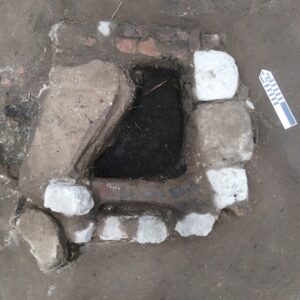
While a doctoral student at the University of California, Riverside, California, Kirby Farah received a Dissertation Fieldwork Grant to aid research on “Creating and Maintaining an Elite Identity: A Study of Elite Domestic Practices at Postclassic Xaltocan,” supervised by Dr. Wendy Ashmore. Two years later Dr. Farah had the opportunity to return to the field when she received an Engaged Anthropology Grant to carry out her project, “Middle Postclassic Ritual Spaces and Implements: A Museum Exhibit at Xaltocan, Mexico”.
My Wenner Gren funded dissertation research, conducted between July 2014 and June 2015, focused on the everyday lives and identity practices of the Postclassic (A.D. 900-1521) leaders of Xaltocan, Mexico. From the outset, this project was informed by community engagement. I collaborated with local Xaltocan residents to outline a set of research objectives that prioritized transparency and rapid dissemination of research results. We also worked together to design research questions that would glean locally-relevant knowledge about Xaltocan’s prehispanic past. This might include knowledge that (1) contributes to cultivating local pride, (2) is of general interest to the local community, or (3) adds perspective to issues facing Xaltocan (and other Basin of Mexico communities) today. Too often we as archaeologists dive into our projects with our own research questions in mind, rarely taking into consideration whether or not the topics we focus on are important to local communities. Collaborating early on creates avenues for integrating topics that emphasize our interests as researchers as well as the interests of the communities most impacted by our work.
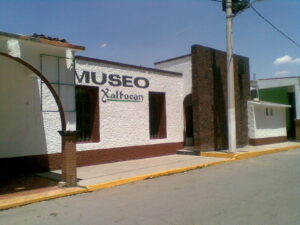
Among other things, my conversations with community members revealed a particular interest in the lives and practices of Xaltocan’s Postclassic rulers, an understudied topic at Xaltocan. There was also a strong interest in understanding the cultural practices that distinguished Xaltocan from other Postclassic Basin of Mexico polities. In order to address these topics and to learn more about the nature of leadership and community identity at Postclassic Xaltocan, I conducted excavations at Cerrito Central, a large mound located near the modern town center. These excavations recovered the remains of successive monumental buildings that likely served as the residences of Xaltocan’s Postclassic leaders. Data collected from in and around these buildings, which dated to roughly the Early (AD 900-1240), Middle (AD 1240-1350), and Late Postclassic (1350-1521), provided a better understanding of the ways in which leadership strategies shifted over time and in response to changing local and regional dynamics.
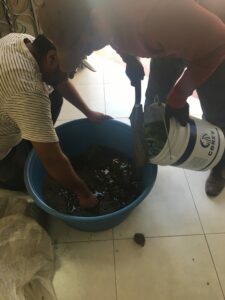
Excavations at Cerrito Central recovered important data concerning the everyday practices of Xaltocan’s leaders throughout the Postclassic. However many of the most interesting findings were associated with the Middle Postclassic, the periods during which Xaltocan reached peak political prominence in the region. In particular, the recovery of two ritual spaces—one private and one public—revealed the various practices and implements used by Xaltocan’s leaders to interact with the gods.
The private ritual space was a small room that contained the remains of five successive altars. The altars and the wall foundations surrounding the room were lined along the surface with ceramic fragments. The public area was an open patio just north of the altar room. The patio contained the remains of a ceremonial hearth—which also incorporated ceramic fragments—and a large ritual deposit. Thus, in both spaces ceramic fragments were used to mark or outline ritual space. Both spaces were also associated with burning practices. The private rituals involved the use of censers and braziers to contain smoking copal resin, whereas the public ritual involved an open fire that burned in the ceremonial hearth. Combined, these findings provide evidence for a complex ritual program at Xaltocan that involved ritual symbols that have not been observed elsewhere in the Basin of Mexico.
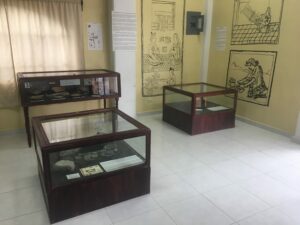
I concluded that the ritual features and implements recovered in these Middle Postclassic contexts spoke to the research questions we designed. The ritual practices of Xaltocan’s leaders reflect their political and religious role in the community. Furthermore, the use of ceramic fragments to outline ritual spaces reflects a culturally distinctive practice that may have been unique to Xaltocan. In order to make these findings more accessible to the local community, I returned to Xaltocan in 2017 to install a permanent museum exhibit that would showcase our recent findings and provide detailed information about their significance. This exhibit was funded by a Wenner-Gren Engaged Anthropology grant. The exhibit was designed to showcase the Middle Postclassic ritual implements of Xaltocan’s rulers and to teach visitors about the nature of ritual practice during the Postclassic. As a permanent installation, the exhibit will serve as a learning tool for generations to come.
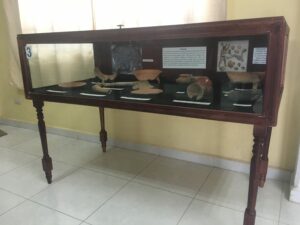
The exhibit includes artifacts recovered from Middle Postclassic ritual contexts as well as replicas of some of the ritual features. These artifacts and features are contained in three large vitrines. The first vitrine contains a replica of one of the altars recovered in the private room, the second contains a replica of the ceremonial hearth, and the third contains the reconstructed artifacts recovered from a ritual deposit. A plaque with detailed descriptions of the features and objects accompanies each vitrine. A map of the excavation area is also included, which allows visitors to understand the spatial relationships of the objects on display. The exhibit also includes a large informational panel that outlines the nature ritual practice at Xaltocan and in the Basin of Mexico, with special focus on the New Fire ceremony. The second and third vitrines contain the remnants of a public ritual that may have been an early version of the New Fire ceremony, which would become one of the most important state-sponsored rituals of the Aztecs.

The exhibit was completed in August 2017 and we held an opening ceremony to mark the event. Attendees included government officials and members of local cultural and educational institutions, but most attendees were children and families from Xaltocan. I kicked off the event with an introduction to the exhibit and the directors of the local museum and cultural center also spoke. I was also happy to welcome most members of the original excavation team, who spoke about their experiences and answered questions. As a follow-up to the success of the opening ceremony and the exhibit, a symposium is being planned form summer 2019. The symposium will be future-focused, and address the relationship between local patrimony and archaeological research at Xaltocan.